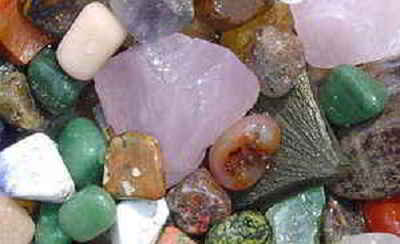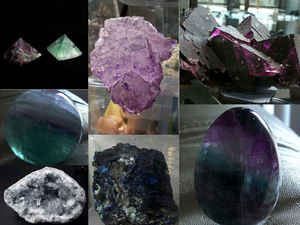
California Symbols
California State Mineral & Mineralogic Emblem
Gold

(Au) Element 79
Adopted on April 20, 1965
As one might expect, gold is the official state mineral and was so designated in 1965. On April 20, Governor Edmond G. Brown signed Senate Bill No. 265, designating native gold as the official state mineral and mineralogic emblem and serpentine the official rock and lithologic emblem of the State of California.
In the four years following the discovery of gold by James Marshall in January of 1848, California's population swelled from 14,000 to 250,000 people. Miners came from all over the world and extracted 28,280,711 fine ounces of gold from 1850-1859 which would be worth approximately $10,000,000,000 today. Although production is much lower, present day prospectors can still pan for gold in California's streams. In 2001, California ranked fourth in the United States in gold production. Approximately 449,200 troy ounces were produced worth about $122.3 million.
Califonia State Mineral & Mineralogic Emblem: Gold
 California was the first state to
designate an official state rock, Serpentine in 1965. California also designated gold as
the state mineral in 1965. California's nickname is the Golden State. California designated Benitoite as the state
gemstone in 1985. It is only found in gem quality in San Benito County, CA.
California was the first state to
designate an official state rock, Serpentine in 1965. California also designated gold as
the state mineral in 1965. California's nickname is the Golden State. California designated Benitoite as the state
gemstone in 1985. It is only found in gem quality in San Benito County, CA.
The accidental discovery of gold in 1848 at Sutter's Mill in Coloma started a bonanza that brought California fame and gave it the title of the "Golden State."The Gold Rush of 1849 and the subsequent influx of settlers led to California becoming the 31st state in 1850.
NATURAL OCCURRENCES OF GOLD
 The concentration of gold ore,
and the market value of gold determine whether a deposit is a mineable ore body. The highest grade deposits are associated with quartz veins. Gold also occurs as
disseminated particles incorporated during magmatic rock formation or during subsequent chemical alteration of the host rock. Primary gold occurrences are termed lode
deposits. Mineralized rock and gold bearing veins release gold particles during the weathering process. Because of its high specific gravity and resistance to weathering,
these sedimentary gold particles are easily concentrated by streams and rivers to form placer gold deposits.
The concentration of gold ore,
and the market value of gold determine whether a deposit is a mineable ore body. The highest grade deposits are associated with quartz veins. Gold also occurs as
disseminated particles incorporated during magmatic rock formation or during subsequent chemical alteration of the host rock. Primary gold occurrences are termed lode
deposits. Mineralized rock and gold bearing veins release gold particles during the weathering process. Because of its high specific gravity and resistance to weathering,
these sedimentary gold particles are easily concentrated by streams and rivers to form placer gold deposits.
PROPERTIES AND USES OF GOLD
 Gold is one of the earliest
metals known and used by humans. It resists corrosion and chemical interaction. It will not disintegrate when exposed to oxygen, water, salt, or any other
naturally-occurring material. Gold's durability accounts for the almost perfect condition of coins and artifacts fashioned from it thousands of years ago. Gold's most
important use is in computers, weaponry and aerospace. It is used where consistent, reliable performance under all conditions is essential. The electronics industry has
tried to find substitute metals and alloys, but gold's exceptional resistance to corrosion and tarnish is still unequaled.
Gold is one of the earliest
metals known and used by humans. It resists corrosion and chemical interaction. It will not disintegrate when exposed to oxygen, water, salt, or any other
naturally-occurring material. Gold's durability accounts for the almost perfect condition of coins and artifacts fashioned from it thousands of years ago. Gold's most
important use is in computers, weaponry and aerospace. It is used where consistent, reliable performance under all conditions is essential. The electronics industry has
tried to find substitute metals and alloys, but gold's exceptional resistance to corrosion and tarnish is still unequaled.
GOLD DEPOSITS IN CALIFORNIA
California's most important gold deposits have been found in the Sierra Nevada, Klamath Mountains and Mojave Desert. Significant deposits have also been developed in the Peninsular and Transverse Ranges and the northern Great Valley. Unmined low-grade deposits occur statewide. In the Coast Ranges, low-grade gold deposits are associated with low-temperature mercury mineralization.
Physical Characteristics of Gold:
 Gold is a chemical element with the symbol Au and atomic number 79. It is a dense, soft, malleable and ductile metal with a bright yellow color and luster, the properties of
which remain without tarnishing when exposed to air or water. Chemically, gold is a transition metal and a group 11 element. It is one of the least reactive chemical elements,
and is solid under standard conditions. The metal therefore occurs often in free elemental (native) form, as nuggets or grains, in rocks, in veins and in alluvial deposits.
Less commonly, it occurs in minerals as gold compounds, such as with tellurium as calaverite, sylvanite, or krennerite.
Gold is a chemical element with the symbol Au and atomic number 79. It is a dense, soft, malleable and ductile metal with a bright yellow color and luster, the properties of
which remain without tarnishing when exposed to air or water. Chemically, gold is a transition metal and a group 11 element. It is one of the least reactive chemical elements,
and is solid under standard conditions. The metal therefore occurs often in free elemental (native) form, as nuggets or grains, in rocks, in veins and in alluvial deposits.
Less commonly, it occurs in minerals as gold compounds, such as with tellurium as calaverite, sylvanite, or krennerite.
- Name gold
- Symbol Au
- Atomic number 79
- Atomic weight 196.966569
- Color is golden "butter" yellow.
- Luster is metallic.
- Transparency is opaque.
- Crystal System is isometric; 4/m bar 3 2/m
- Crystal Habits include massive nuggets and disseminated grains. Also wires, dendritic and arborescent crystal clusters.
- Cleavage is absent.
- Fracture is jagged.
- Streak is golden yellow.
- Hardness is 2.5 - 3
- Specific Gravity is 19.3+ (extremely heavy even for metallic minerals)
- Associated Minerals include quartz, nagyagite, calaverite, sylvanite, krennerite, pyrite and other sulfides.
- Other Characteristics: ductile, malleable and sectile, meaning it can be pounded into other shapes, stretched into a wire and cut into slices.
- Notable Occurrences include California and South Dakota, USA; Siberia, Russia; South Africa; Canada and other localities around the world.
- Best Field Indicators are color, density, hardness, sectility, malleability and ductility.
California Senate Bill No. 265
CHAPTER 89
An act to add Sections 425.1 and 425.2 to the Government Code, relating to state emblems.
[Approved by Governor April 20, 1965. Filed with Secretary of State April 20, 1965.]
The people of the State of California do enact as follows:
SECTION 1. Section 425.1 is added to the Government Code to read:
425.1. Native gold is the official State Mineral and mineralogic emblem.
SEC. 2. Section 425.2 is added to the Government Code to read:
425.2. Serpentine is the official State Rock and lithologic emblem.
California Government Code, Title 1, Division 2, Chapter 2.
CALIFORNIA GOVERNMENT CODE
TITLE 1. GENERAL
DIVISION 2. STATE SEAL, FLAG, AND EMBLEMS
CHAPTER 2. STATE FLAG AND EMBLEMS
SECTION 420-429.8
425.1. Native gold is the official State Mineral and mineralogic emblem.
Characteristics of Gold |
|
|---|---|
| Mineral class | Elements : Copper-silver-gold group |
| Chemical formula | Au |
| Crystal system | Cubic |
| Habitus | As grains, crack fillings and jugs. Rarely as octaedric crystals. |
| Cleavage | None, malleable. |
| Hardness | 2.5-3 |
| Density | 19.3 |
| Color | Yellow, without tarnish. |
| Streak | Yellow shiny. |
| Luster | Metallic |
| Description | |
| Occurance | Primarily in quartz veins of hydrothermal origin, but also as magmatic and metamorphic rock. Concentrated in alluvial deposits. |
| Associates | Quarts, sulfides. |
Minerals, & Gems

Gemstone, Minerals, Rocks






